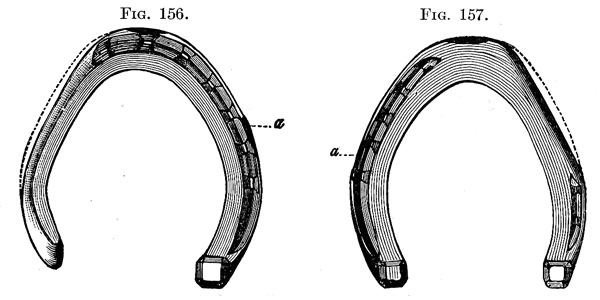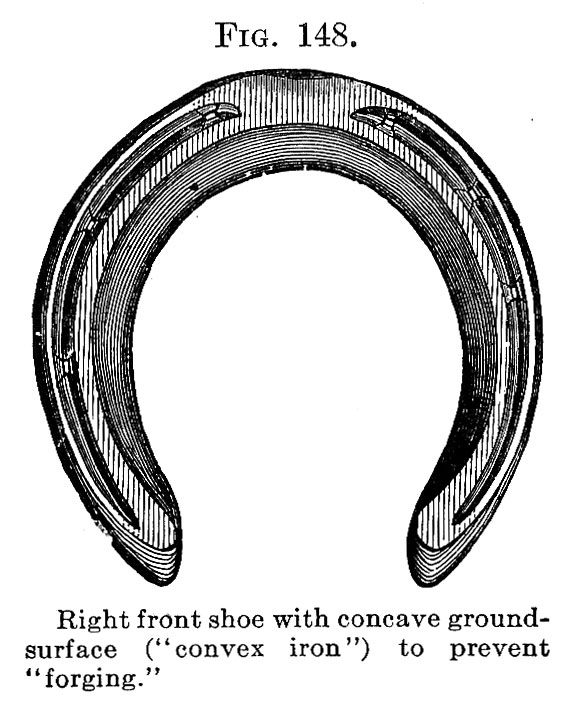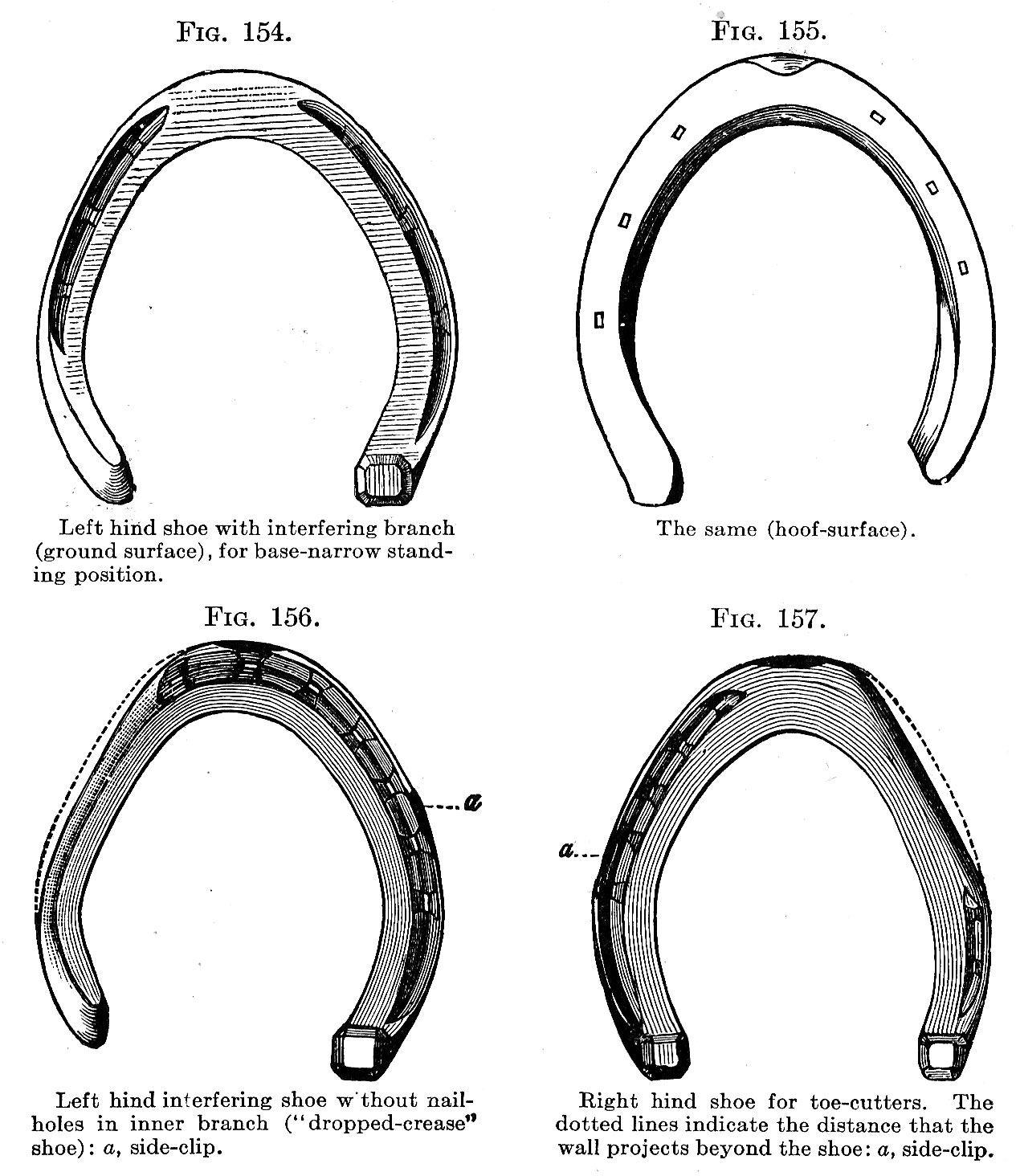
Horseshoeing Part 4B
A Text-Book of Horseshoeing
Part 4B
by A. Lungwitz and John W. Adams Copyright 1897
CHAPTER IV.
SHOEING HORSES THAT FORGE AND INTERFERE.
A. Forging.
Forging is that defect of the horse’s gait by reason of which, at a trot, he strikes the ends of the branches or the under surface of the front shoe with the toe of the hind shoe or hoof of the same side. Forging in a pacer is termed “cross-firing” and consists in striking the inner quarter, or the under surface of the inner branch of a front shoe with the toe of the diagonal hind shoe or hoof.
Forging is unpleasant to hear and dangerous to the horse. It is liable to wound the heels of the forefeet, damages the toes or the coronet of the hind hoofs, and often pulls off the front shoes.
Causes. – 1. Faulty conformation; for example, horses that stand considerably higher at the croup than at the withers; horses with long legs and short bodies; horses that “stand under” in front and behind. 2. Using horses on heavy ground, unskilful driving, allowing a long-necked, heavy-headed horse to carry his head too low; riding without holding a horse to his work by feeling his mouth and pressing the knees against his sides. 3. Fatigue frequently leads to forging, even in horses that are well built and properly shod. It may also occur in the act of vaulting over an obstacle. 4. Poor shoeing, especially too long toes upon the front and hind hoofs, and too long front shoes.
The aim of the shoer should be to facilitate the quick and easy “breaking over” of the front foot, so that it may get away before it is overtaken by the hind foot. The toe of the front hoof should be fairly short and rolled; the quarters spared. The front shoe should be light, rolled at the toe and no longer and no wider than the hoof. The ends of the branches of a flat shoe, and also the heel-calks, in case they are needed to elevate a heel that is too low, should be bevelled from the hoof surface of the shoe downward and forward under the foot. Such short heel-calks, bevelled to prevent forging, are called “forging calks.” If the horse continues to forge between the branches and against the ground surface of the shoe, concaving this surface will prove advantageous (convex iron). The form of the front shoes of horses that forge should represent merely a prolongation of the hoof.
The “breaking over” of the hind foot should be delayed by sparing the toe and lowering the quarters, but not sufficiently to break the footaxis too far backward. The hind shoe is to be squared at the toe and the lower edge of the shoe in the region of the toe well rounded; instead of a toe-clip, two side-clips are to be drawn up and the shoe so fitted that at least three-fourths of the thickness of the wall of the toe, with the edge well rounded, will extend forward beyond the shoe. Should the toe of the hoof be short it may be raised either by a low toe-calk set one-fourth of an inch back from the edge of the shoe, or by thinning the shoe from the toe to the ends of the branches. The branches of a flat hind shoe should extend somewhat farther back of the buttresses than under normal conditions, to trail upon the ground just before the hoof alights, and acting as a brake, to bring the hoof to earth (Fig. 150).
“Cross-firing” is most apt to occur and is most dangerous at extreme speed. Then, when the inner branch of the hind shoe strikes the inner heel, quarter or shoe of the diagonal front foot, both feet are in the air, – the fore foot is approaching the middle of its stride, while the offending hind foot is in the last third of its flight. The standing position that favors cross-firing is the base-wide (toe-wide) in front, and the base-narrow (toe-narrow) behind. With this direction of limbs the flight of the fore feet is forward and inward during the first half of their stride, while the flight of the hind feet is forward and inward during the second half of their stride (see Figs. 72, 73, 75) (in SFJ Vol. 40, No. 4 and/or Horseshoeing Part 2B).
The problem is, therefore, so to pare and shoe a base-wide fore foot that it will break over nearer the centre of the toe and thus execute less of an inward swing during the first half of its stride, and to so pare and shoe a base-narrow hind foot that it will break over nearer the centre of the toe and thus execute less of an inward swing during the second half of its stride. Neither a toe-wide nor a toe-narrow foot can be made to break over the exact centre of the toe, and yet it is possible by dressing the hoof and by shoeing to shift the breaking over point nearer to the centre of the toe, and by doing so, to alter slightly the lines of flight of the feet.
Dressing and shoeing the front foot: The hoof should be relatively low from the middle of the toe around to and including the outer buttress. If the inner half of the wall is deficient in length it must be raised above the outer half by applying a shoe which is thinner in its outer than in its inner branch. The inner toe should be left long.
The shoe should be light, without heel-calks, but may carry a low, curved grab (“grab,” is a low, straight or curved, toe- or heel-calk on a racing plate) running from the second inner toe nail to the centre of the toe. The inner branch is to be fitted flush with the wall from the centre of the toe back to the quarter, back of which point it gradually extends beyond the wall, i.e., is fitted full; and terminates well back of the buttress. This inner branch should be from one-fourth to threeeighths of an inch longer than the outer branch. The long inner branch, full at the quarter, is desirable, but must be covered by a quarter-boot, which a cross-firer should always wear.
The outer branch should be fitted snug and terminate at the buttress. From the centre of the toe to the end of the branch the ground surface should be bevelled from the inner edge of the web to a knife-edge at the outer border.
Dressing and shoeing the hind foot: The hoof should be relatively low from the centre of the toe around to and including the inner buttress. If the outer half of the hoof is deficient in length, it must be raised above the inner half by applying a shoe with a thin inner branch. The inner branch may terminate in a knife-edge midway between toe and heel (Figs. 151 and 152).
The inner branch is to be fitted snug from the centre of the toe to its end, and its ground surface should be bevelled from the inner edge of the web to a knifeedge at the outer border.
The outer branch is to be fitted very full from the outside toe to the end. This branch should extend well behind the buttress, and in well-marked base-narrow hoofs should be turned outward in order to support the overhanging coronet of the quarter. The outer boarder should be bevelled base-wide, and the nail holes punched coarse, i.e., far in from the outer border (Figs. 151 and 152). The outer branch may carry a small heel-calk.
B. Interfering.
A horse “interferes” when a hoof in motion strikes the opposite supporting leg. Interfering is apt to produce injuries, either of the coronary band of the inner half of the foot or of the fetlock-joint, or (in fore-limbs) of the cannon, even as high up as the knee. Lameness frequently accompanies such injuries.
The causes of interfering lie either in the shoeing (of the foot that strikes, as well as of the foot which is struck), in the position of the limbs, or in the use of the animal. Horses that have the correct standing position do not interfere when they are properly shod; base-wide horses interfere sometimes; horses base-narrow down to the fetlock and toe-wide below that point interfere very frequently. Traces of unequal length, weariness, and shoeing at too long intervals favor interfering.
In attempting to lessen or remove interfering, the horse must be most carefully examined with respect to the position of his limbs, his gait, and his shoeing.
If the cause is found to be the twisted position of a shoe, too wide hoofs, raised clinches, etc., nothing need be done further than to correct the shoeing; but if a faulty position of the limbs is the cause, we must ascertain the exact part of the hoof that does the striking, diminish the size of the hoof at that point, regulate the entire plantar surface of the hoof, make the shoe straight along the region that strikes, – that is, without curve, – and so fit it to the foot that one-third of the thickness of the wall will extend beyond the shoe. Where interfering is so pronounced as to produce serious injuries, we use a shoe with no nails in the inner branch (“droppedcrease” shoe) (Figs. 153, 156, 157).
The so-called interfering shoes (Figs. 154 and 155) are worthy of recommendation only for hoofs of the base-narrow position. The interfering branch, whose greater thickness raises the inner wall, which is often too low, is to be so shaped and directed that the hoof will project somewhat beyond it. This interfering branch must be made and shaped in accordance with each individual case. The holes in the interfering branch should be punched somewhat finer (nearer the edge) than usual. Interfering shoes in which the nail-holes, with the exception of the inner toe nail-hole, are placed in the outer branch, are called “dropped-crease interfering shoes” (Fig. 156). Such shoes are not recommended for hind hoofs that are decidedly toe-wide (toe-cutters); in such cases better results will be obtained by using a shoe, either with or without heel-calks, whose inner branch is straight and without nails along the striking region, and is fitted wide (full) at the quarter. The inner branch should be from one-fourth to three-eighths of an inch longer than the outer. The inner heel-calk should be higher than the outer, and the end of the outer branch should be as base-narrow as it can be made (fitted close) (Fig. 157). In order to prevent shifting of an interfering shoe, a side-clip should be drawn up on the outer branch (a).
There is no manner of shoeing that will prevent interfering which is caused by improper harnessing, crooked hitching, or weariness. The simpler and the lighter the shoes the less will horses interfere.










